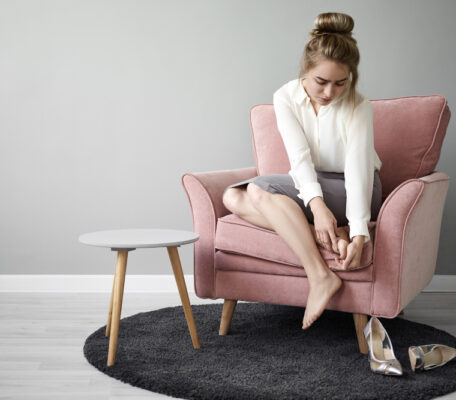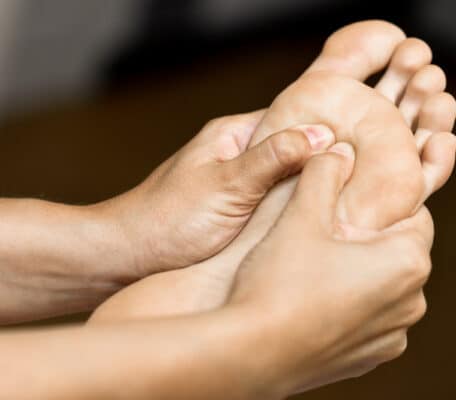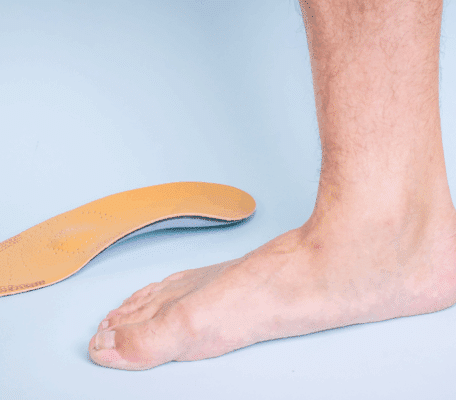With rheumatoid arthritis the ligaments, cartilage, and softer bone of the body is attacked by its own immune system; which is why it is known as an autoimmune disease. This chronic disease starts from the small joints of your hands and feet and works its way to different joints of the body.
How do you know if you have rheumatoid arthritis?
Common Symptoms
Rheumatoid arthritis symptoms on the feet can appear on the ball of the foot, joints, and ankles. Usually there are several joints affected simultaneously by rheumatoid arthritis. The common symptoms that a person with this condition can experience may include:
- Pain, stiffness, and swelling of the foot, joints, and ankles;
- Joints feel warm;
- Corns or bunions can develop;
- Formation of hammer toe or claw toe;
- Bones in the hindfoot and ankle can shift position;
- Collapse of the long arch at the bottom of the foot;
- Difficulty in walking;
- Feeling feverish;
- Loss of appetite;
- Fatigue; and
- Lumps near joints like the elbow.
Symptoms Based on Location
Rheumatoid arthritis usually occurs on both feet unlike with osteoarthritis where a single specific joint is attacked. The same joints on both feet are attacked. The symptoms may vary depending on the location of the rheumatoid arthritis on the foot.
- Ankle – the presence of rheumatoid arthritis at this part of the foot makes it difficult for the person to climb stairs and inclines like ramps. Eventually even walking and standing can cause severe pain.
- Forefoot – this covers the toes and balls of the feet. Claw toes, bunions, and pain under the balls of the feet are unique symptoms associated with rheumatoid arthritis at the forefoot. How can you know if this is a common foot disorder or a symptom? These are symptoms when they occur in combination. For bunions the big toe normally crosses to the second toe. Painful bumps from the joint dislocation of the bones at the midfoot can result in calluses. Wearing shoes may be difficult.
- Midfoot – the rheumatoid arthritis is manifested usually at the top of the foot. The ligaments supporting the midfoot are weakened resulting in the collapse of the arches. As the arch collapses the foot collapses as well and the front part begins to point outward. The cartilage is damaged causing pain regardless whether you are wearing shoes or not. What happens as the structure that supports the foot begin to degenerate? Eventually the foot will begin to change shape and create a huge prominent bump on the arch of the foot. These shape changes will make it difficult to use shoes or even do daily activities like walking or moving around.
- Hindfoot – as the heel region of your foot becomes affected by rheumatoid arthritis, you begin to experience difficulties in walking on certain surfaces like grass, gravel, or uneven ground. These initial symptoms may be accompanied by pain around or beneath the fibula just at the outer side of your foot.
The function of the hindfoot is to help in the side-to-side movement of your foot. With the progression of rheumatoid arthritis the foot alignment shifts and the bones are displaced from their normal position. The most common results are flatfoot deformity, discomfort, and pain at the area of the main tendon supporting the arch at the inside of the ankle or at its outer side under the fibula.
There is no question that rheumatoid arthritis can be a very debilitating disease and knowing that you have it is the first step in knowing how to deal with the pain. Consult with experts on how to properly care for your feet.
At Foot Solutions, we carry a wide range of shoes especially designed for sensitive feet. When these are combined with a custom arch support that matches your foot shape exactly, it can help to relieve the pressures associated with RA.



